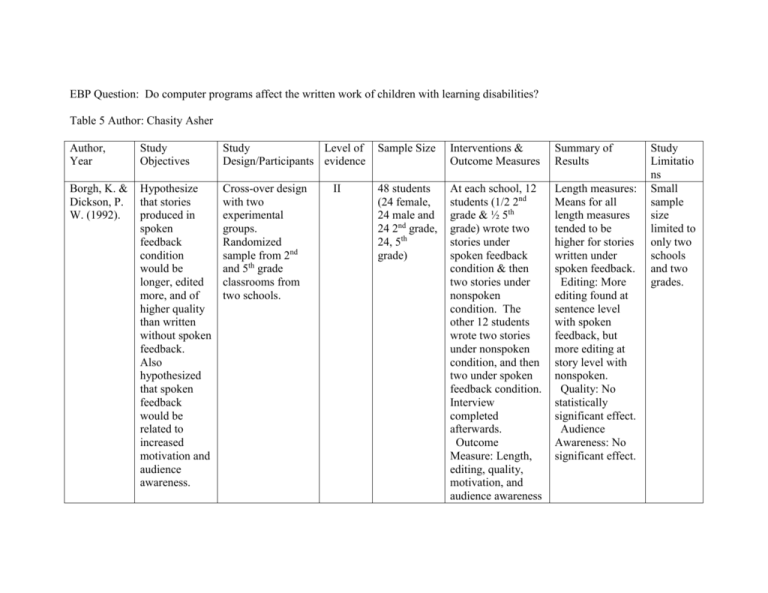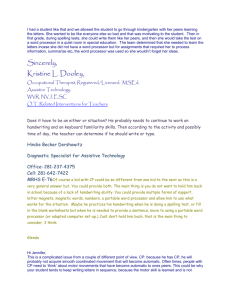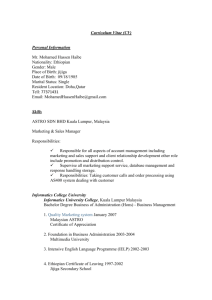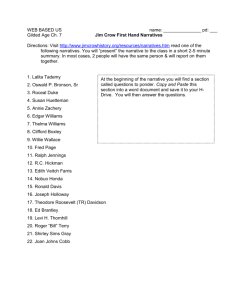Computer - Department of Occupational Therapy
advertisement

EBP Question: Do computer programs affect the written work of children with learning disabilities? Table 5 Author: Chasity Asher Author, Year Study Objectives Study Level of Design/Participants evidence Sample Size Interventions & Outcome Measures Summary of Results Borgh, K. & Dickson, P. W. (1992). Hypothesize that stories produced in spoken feedback condition would be longer, edited more, and of higher quality than written without spoken feedback. Also hypothesized that spoken feedback would be related to increased motivation and audience awareness. Cross-over design with two experimental groups. Randomized sample from 2nd and 5th grade classrooms from two schools. 48 students (24 female, 24 male and 24 2nd grade, 24, 5th grade) At each school, 12 students (1/2 2nd grade & ½ 5th grade) wrote two stories under spoken feedback condition & then two stories under nonspoken condition. The other 12 students wrote two stories under nonspoken condition, and then two under spoken feedback condition. Interview completed afterwards. Outcome Measure: Length, editing, quality, motivation, and audience awareness Length measures: Means for all length measures tended to be higher for stories written under spoken feedback. Editing: More editing found at sentence level with spoken feedback, but more editing at story level with nonspoken. Quality: No statistically significant effect. Audience Awareness: No significant effect. II Study Limitatio ns Small sample size limited to only two schools and two grades. Dalton, D. W. & Hannafin, M. J. (1987). Study the effects of a year-long word processing program on holistic writing skills. A 2x2 completely crossed treatment by-achievement factorial design. Nonrandomization drawing from four remedial language arts courses, which were placed in courses based on below-average scores on Comprehensive Test of Basic Skills. II 80 seventh grade students Students were split into two groups using different programs: Word processing treatment (WPT) and Conventional writing program (CWP), with both higher and lower achievers. WPT completed written assignments on an Apple equipped with FreeWriter and CWP used pen and pencil. Both groups completed two weekly writing exercises and four additional major papers. Lastly completed a writing sample end of research. Outcome measures: Posttest writing sample evaluated by “blind” examiners High achievers essay scores were significantly higher than low achievers. Mean scores of WPT group were significantly higher than the CWP group. Low achieving learners benefited more from WPT than high achieving learners. Interview suggested that word processor improves revision in written assignments. Not randomiz ed and limited to certain age group. Goldberg, A., Russell, M., & Cook, A. (2003). A study on the impact of computer processing on K-12 students’ writing. Meta analysis including 26 studies between 1992-2002, K-12 students. I according to structure and organization, correct usage of parts of speech, punctuation, capitalization, and spelling subtracting points from 100 for mistakes to find scores. Interviews also conducted. 26 studies, From review of approximatel literature, a coding y 1320 system was used to students. examine results. Coding included: publication type, research methodology, student characteristics, technology related factors, writing environment factors, instructional support factors, and outcome measures. Outcome measures: Quality, Quantity: Across 14 studies, students who write with word processors tend to produce longer passages than students who write with paper and pencil. Quality: 15 studies indicate that students who write with word processor tend to produce higher quality passages than students who write with pencil HandleyMore, D., Deitz, J., Billingsley, F. F., & Coggins, T. E. (2003). Investigation of whether occupational therapy intervention that focused on teaching children to use word processing, either alone or with word prediction, was effective in improving the written communication skills of children with learning Single-subject alternating treatment design. Participants were identified by OT, school pathologist, or special education teacher. They were diagnosed with a learning disability and in grades 4 and 5. IV 3 students quantity, and revision. and paper. Revision: 6 studies show that students who write with word processor made more revisions than those who write with pencil and paper. Prior to phase one: Each student preselected 36 pictures they could write about. Phase One/Baseline: completed 6 handwritten stories. Prior to phase two keyboard training. Phase two: Completed 18-29 stories using handwriting, word processing, and word processing with word prediction. Outcome Two children demonstrated clear improvement in legibility with use of word processor alone or with word prediction. These same students also demonstrated clear improvements in spelling using word prediction. Rate of writing was best for two children using handwriting, however quantity Small sample size, nonrandomiz ation in participan ts. Study also restricted to one school district. disabilities and handwriting problems. MacArthur, C. A. & Cavalier, A. R. (2004). Investigate the feasibility and validity of dictation using speech recognition software and dictation to a scribe as accommodatio n for test involving extended writing for children with and without learning disabilities. Experimental design, repeated measures group design High school students with and without Learning Disabilities. II measures: Legibility, spelling, and total amount written. 31 high In initial 8 sessions, school students received students: 21 training on speech students with recognition LD and 10 program and essay students writing. Students without LD. wrote three essays on certain topics in three sessions using all three conditions: Handwriting, Speech Recognition, and dictation with scribe. Random assignment was used for order. Outcome measures: Accuracy, quality, length, vocabulary, and errors. did not have a preferable method. Significant difference was found for students with learning disabilities between handwriting (HW) and speech recognition (SR). SR scores were higher in quality, length, vocabulary, and had less errors than HW scores for students with learning disabilities. There was no significant difference in HW and SR scores for students without learning disabilities. Small sample size and restricted to one school district. Students were handpick ed by teachers. MacArthur, C. A. & Graham, S. (1987) Investigate how different methods of text production affect the writing processes and products of Learning Disabled (LD) students. QuasiExperimental study with multiple measures. Fifth and sixth grade students with Learning Disabily. III 11 students The students completed initial interview about their writing, (“do you like to write, what do you like about writing, and what do you find difficult”). Each student composed three stories about response to pictures provided using each of the three methods: Handwriting (HW), word processing (WP), and dictation (D). Measure outcomes: length, errors, revisions, quality, and time. Quinlan, T. (2004). Investigate how composing with Speech Recognition Quasiexperimental study, repeated measure design. 11 to 14 years III 41 children The 41 children were split into groups: Fluent writers and nonfluent writers Dictated stories were significantly longer, were of higher quality, and had fewer grammatical errors than HW and WP stories. HW and WP stories did not differ on any of the product measures, including length, quality, story structure, mechanical or grammatical errors, or vocabulary. However, revisions and composing rate were better with WP than HW. Less fluent children’s narratives were inferior to fluent children’s Small sample size and limited to one school district. Restricte d to fifth and sixth grade students. No randomiz ation. Length of study included only one session (SR), in old, both fluent and combination less fluent writers. with advanced planning, affect the writing performance of less fluent writers. Wetzel, K. (1996). Answer questions: “Can elementary students learn Qualitative, Exploratory study. Case study with a 6th grade student diagnosed with a V One student according to pretest scores. Children from both groups attended one 6-hour writing class, which included instruction on use of SR and four written narratives. The narratives were written using handwriting method and speech recognition method, both with and without advanced planning. Outcomes measures: Narratives were analyzed for number of words, holistic quality, surface errors, and t-unit length. Met with student 30 minutes per week for 14 weeks. First, the student was given lessons using narratives. with Speech children. recognition significantly increased length of written work, as well as decreased the amount of errors in writing. However, quality of writing was not significantly increased by SR. Advanced planning also assisted in children in developing stories. The student learned how to use the Voice Type Speech Recognition Limited to one student. Outcome measures to use learning disability VoiceType?”, “Is the technology powerful enough to support the kinds of tasks students are assigned?”, and “Does the entire process result in students’ improved communication ?” William, S. C. (2002). Examine the experience of a single student with learning Qualitative, Case study One student in grade K-8 with a V One student VoiceType speech recognition program and prewriting skills. Each session included a review of VoiceType commands and procedures, teaching of new procedures, and a writing segment. He completed seven short personal narratives throughout the study. Outcomes Measures: Examination of student’s mastery with program, adequacy of system’s response, and potential for improvement in writing. The student completed a 20minute journal entry session in program and worked well with it although he did have some troubles. VoiceType recognized 74% of his words. Student completed 6 narratives, in which teacher recognized as an improvement. She stated that prior to study, he usually did not finish narratives on his own. were not precise. Student’s word count in journal entries increased with computer Limited to one student. Research disabilities in a learning disability. written expression and his use of word prediction and speech feedback software during journal writing. Outhred, L. (1989). Study effect of word processor on written work of children with learning disabilities. Quasi-Experimental design, purposive sample. Students were 812 years old and diagnosed with learning disability. class daily using word processor, word prediction, and speech feedback. Outcome measures: Word count, quality, and attitude. III 15 students Students’ session attendance ranged from 12-21 school weeks. Each week, students wrote two stories, one in handwriting and one with word processor. The teacher assigned a topic each time and allowed 30 minutes for writing. Outcome Measures: Fluency (word count) and misspellings. software and his holistic quality increased almost a full point, which to someone with writing difficulty is a significant increase. His attitude toward writing also increased. Half of the children who had longer handwritten stories had on average 19 more word in length than stories written with word processor. However, the other half of children whose stories were shorter had an increase in word count using word processor than handwriting. There was a questions were broad. Small sample size and sample was not random. Limited to one school district. significant decrease in spelling errors using word processor with most of the children. One article found that speech feedback resulted in an increase in children’s written work along with more revisions made at sentence level. However, quality and audience awareness did not show a significant change. Five of the studies, mostly level I and II studies, using word processor and/or word prediction as an intervention found that the students’ writing increased in quality and length, and errors decreased. However, one study (Level III) found that written work using the word processor program did not differ from handwritten work in length, quality, story structure, mechanical or grammatical errors, or vocabulary, while revisions and composing rate did increase with word processor. As for intervention using speech recognition, three studies found the program to be effective. Two of these studies found improvement in the length, quality, vocabulary, and revisions in the children’s written work. The other study, which is a level III evidence, found an increase in length, and revisions, but did not see a significant increase in the quality of written work. Most studies found that the computer programs allowed for an increase in motivation for children when writing.








